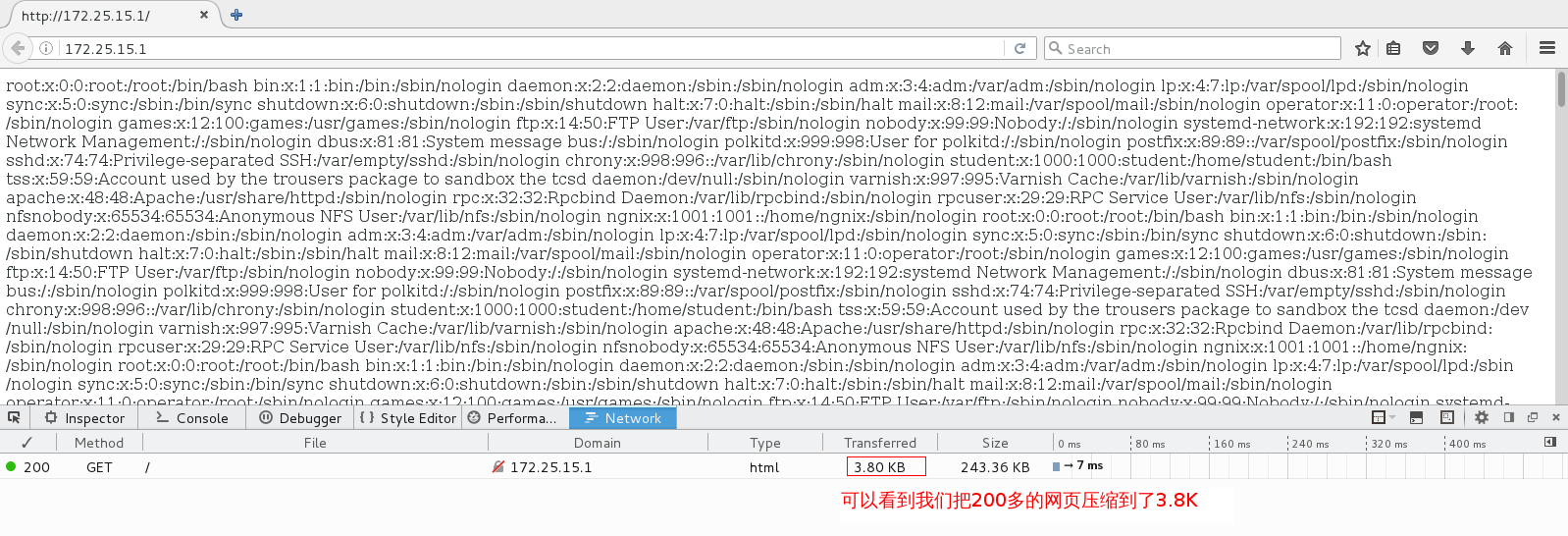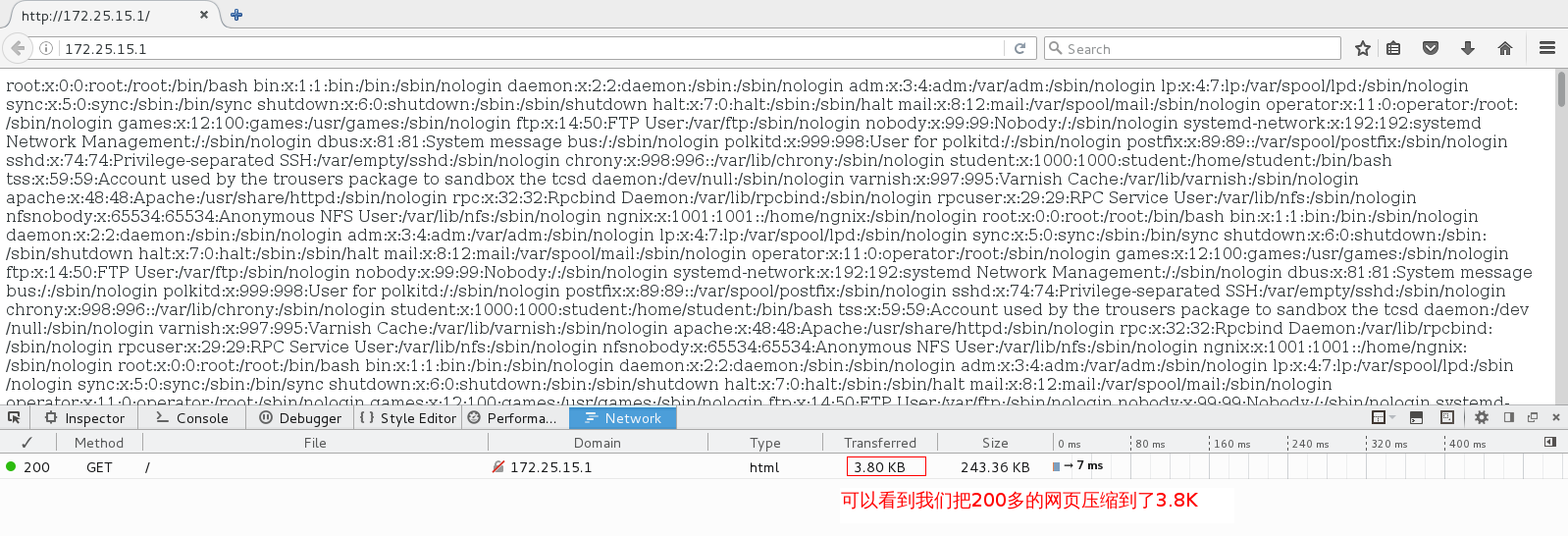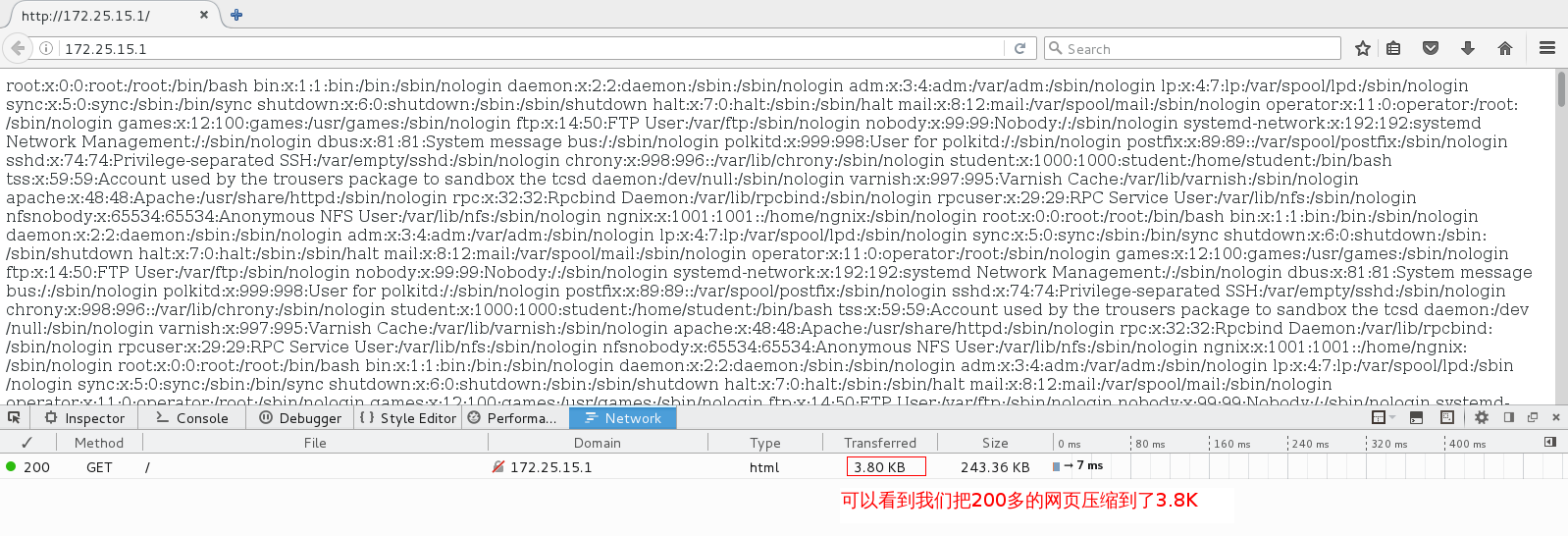Experimental environment
We write index.html in/usr/local/nginx/html on a virtual machine with nginx configured. We can access the web successfully and the size of the web page is more than 200 k
configuration file
Nginx compresses web pages and needs to modify niginx's configuration file.Let's first look at what nginx's configuration file contains:
#1. Define the user and user group that Nginx runs as nginx, which means that the worker's work control group is the nginx user, in order to ensure the security of the system.
user nginx nginx;
#2. Number of processes, which is the process of processing requests (known as the receptionist), can be initially set to the total number of cpu cores such as worker_processes 8;
worker_processes 2;
#3. Global error log definition type
#error_log logs/error.log;
#error_log logs/error.log notice;
#error_log logs/error.log info;
#4. Log the process number to a file to manage nginx processes
#pid logs/nginx.pid;
#5.The maximum number of open files in Nginx's event model can be set to the result of ulimit-HSn after system optimization.
//That is, 1024 can be changed to 65535 and then modified in the / etc/security/limits.conf file, which is the default number of connections for nginx.
//Just modify it in this file
events {
worker_connections 1024; #Maximum number of connections for nginx = number of worker connections * number of worker processes
}
#6.Setup section of HTTP module
http {
include mime.types; #File extension and file type mapping table
default_type application/octet-stream; #Default file type
#log_format main '$remote_addr - $remote_user [$time_local] "$request" ' #Define logging format for logs
# '$status $body_bytes_sent "$http_referer" '
# '"$http_user_agent" "$http_x_forwarded_for"';
#access_log logs/access.log main;
sendfile on; #Turn on efficient file transfer mode for kernel zero copy
#tcp_nopush on; #Activating the tcp_nopush parameter allows httpresponseheader and file start to be published in one file, reducing the number of network message segments
#keepalive_timeout 0; #Connection timeout in seconds
keepalive_timeout 65;
#gzip on; #gzip compression is extremely important for site optimization
#7. Set up the domain name-based virtual host section
server {
listen 80; #The port to listen on can also be in the form of 172.25.254.1:80
server_name localhost; #domain name
#charset koi8-r;
#access_log logs/host.access.log main;
location / { #location Tag Segment for Default Access
root html; #Site root directory, which is the directory where the site program resides
index index.html index.htm; #Sort First Page
}
#error_page 404 /404.html;
# redirect server error pages to the static page /50x.html
#
error_page 500 502 503 504 /50x.html;
location = /50x.html {
root html;
}
# proxy the PHP scripts to Apache listening on 127.0.0.1:80
#
#location ~ \.php$ {
# proxy_pass http://127.0.0.1;
#}
# pass the PHP scripts to FastCGI server listening on 127.0.0.1:9000
#
#location ~ \.php$ { #Requests that match the php extension are dispatched to the fcgi server
# root html;
# fastcgi_pass 127.0.0.1:9000; #Port 9000 thrown to this machine (php fastcgi server)
# fastcgi_index index.php; #Set Dynamic Home Page
# fastcgi_param SCRIPT_FILENAME /scripts$fastcgi_script_name;
# include fastcgi_params; #Set parameters to interact with fastcgi to include files
#}
# deny access to .htaccess files, if Apache's document root
# concurs with nginx's one
#
#location ~ /\.ht {
# deny all;
#}
}
# another virtual host using mix of IP-, name-, and port-based configuration
#
#server {
# listen 8000;
# listen somename:8080;
# server_name somename alias another.alias;
# location / {
# root html;
# index index.html index.htm;
# }
#}
#8.http Virtual Host
# HTTPS server
#
#server {
# listen 443 ssl;
# server_name localhost;
# ssl_certificate cert.pem;
# ssl_certificate_key cert.key;
# ssl_session_cache shared:SSL:1m;
# ssl_session_timeout 5m;
# ssl_ciphers HIGH:!aNULL:!MD5;
# ssl_prefer_server_ciphers on;
# location / {
# root html;
# index index.html index.htm;
# }
#}
}
Start Compression
Let's look at the web page to see what compression it supports.Page Type

I wrote a web page that supports gzip, so I modified the content of the gzip section in the configuration file
gzip on; #Turn on gzip compression gzip_min_length 1; #Minimum compressed file is 0.1k gzip_comp_level 3; #Compression Level 3 gzip_types text/plain appliaton/x-javascript text/css application/xml text/javascripts application/x-httpd-php image/jpeg imgae/gif image/png; #Compressed file type

Then check if the syntax of the profile I wrote is correct
/usr/local/nginx/sbin/nginx -t

When it shows is ok, success means there are no grammar errors, if there are any, it will tell you exactly where the errors are
Then restart the service
Both systemctl restart nginx and systemctl reload nginx can be restarted

Access on the Web
Here's a reminder: when you revisit a web page, you must clear the previous cache, or you won't see any effect.




